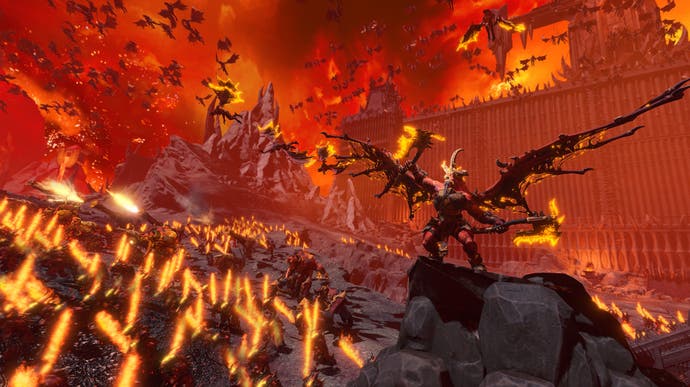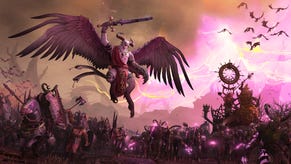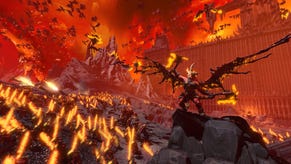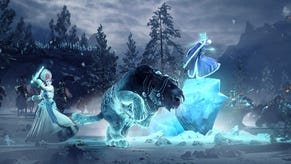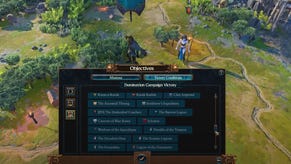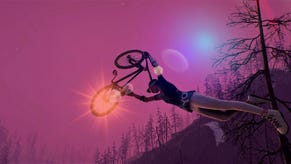Total War: Warhammer 3 review - a thrilling, exhausting mosh pit of strategy
Korn berzerkers.
Tutorials! I am a fan. Good tutorials are rare and actually enjoyable ones rarer still, and Total War: Warhammer 3's is a treat. This is helpful, because there is a lot of Total War out in the world now - this is the third game in its little high-fantasy sub-series and something like the fifteenth full-sized Total War overall - and that means it might be just a tad intimidating for new players.
It's intimidating for me, at least, and I've been bumbling around these turn-based overworlds since the Medieval era. Warhammer 3, as a likely result of those decades of iteration, has an extraordinary amount of systems to it. It's overloaded at times, caught up in the fun of all that Daemonic excess.
But that's also the joy of it. This is the silliest, most convoluted, most chaotically maximalist Total War game I've played. Showing it to someone who'd only played Rome or Shogun would be like picking up a giant amp and travelling 700 years back through time to blast Slayer's Reign in Blood at a Catholic peasant. It's fireballs and flailing tongues and weird spikes. Cannibals, horrible gaping orifices, frog-legged bird wizards, and basic, bottom-tier units that somehow utilise ranged attacks and melee attacks and regenerating shields and magic damage, all at once (I hate them!). And just walls and walls and walls of tech trees, tooltips, and multipliers on top. Streuth!
Anyway, the point is thank the frog-legged bird gods for Warhammer 3's tutorial. It's a marked step-up in onboarding for this series, which has always been at least okay at it, and I'm emphasising its importance in Warhammer 3 not just because the game is absolute carnage but because it's also a lovely prologue for the wider story - if we can call it that - of the main sandbox campaign. In it you play as an honourable Kislev lord who marches north into Chaosville in search of his missing bear-god, Ursun. Can you spoil a prologue? Someone probably thinks so, so just take the time to play it for a bit of delightful, trademark Games Workshop grimdark fantasy lore before you jump into the sandbox.

I can pick at it. In fact I can pick at a lot of Warhammer 3. The prologue does well to re-familiarise you with the absolute basics of Total War but it does invest a little too much time into the old "left-click an army to select it" side of things, when what would truly be welcome is a gradual introduction to Warhammer 3's reams of mini-mechanics, say, or the lesser-known intricacies of manoeuvring armies around the world map, or the specifics of each of the eight playable race's several unique elements. Still, it's an on-ramp, and there's a new, lesser-trumpeted system of "tours" that you can take around certain elements once you kick things off for real too that arguably explain the smaller things better. And again, once you do kick things off for real, what a trip.
Warhammer 3, predictably, sprawls its grand campaign across an expansive, gorgeously implemented map. Like the previous two it inserts a twist to the basic go-and-conquer-everything sandbox by adding a main objective, and again like the previous two this results in a kind of wave-based system of recurring climaxes and a Wacky Races sprint to complete your goals first. In the first it was a late-game wave of Chaos enemies rushing in from the north; in the second it was a rush to complete several rituals; here in Warhammer 3 you need to reach Ursun - whether your intentions are benevolent or less so - by travelling to each of the four Chaos Realms, working your way through them and defeating their respective bosses in turn.

This is made possible by a series of Rifts opening up across the map, periodically sprouting like molehills for a dozen or so turns before disappearing again. The twist to that is that these Rifts allow you to do more than just travel to the realms of Slaanesh, Khorne and the gang. You can also fast-travel an army from one Rift to another, right across the map if you like, or you can just close them by sending an army there - which is often a good idea because as long as a Rift stays open, Chaos armies of their respective flavours will bundle through them onto your land.
In practice it makes for an extremely hectic experience. I opted to play as Grand Cathay, hoping to apply what I'd learned from my earlier preview (screw you Iron Dragon), which means that on top of these periodic waves of Chaos invasions I also have to manage... periodic waves of Chaos invasions. Grand Cathay starts next to a giant wall called the Grand Bastion, which can be attacked at four points by the various Chaos armies that spawn on the other side. Over time the Grand Bastion threat meter fills up - you can do some tinkering to slow that town, albeit only slightly - and when it's full it's siege time for a couple of turns.
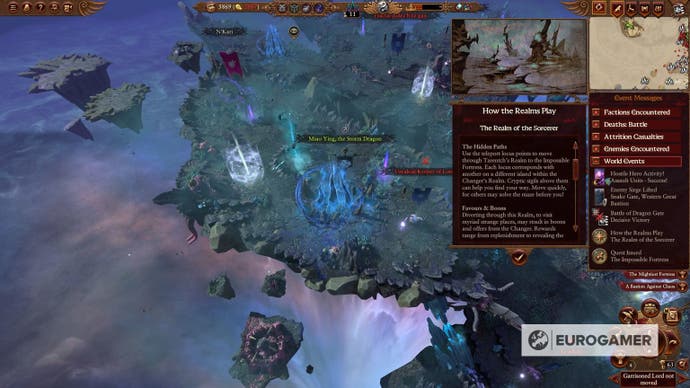
The combination of the two is a mixed bag. On the one hand, the balancing act of sending your main army - which must be spearheaded by your faction leader - off on offensive forays into the Chaos Realms, while playing whack-a-mole with other rifts, southerly Ogre invasions, and north-westerly sieges of the Grand Bastion is a brilliant challenge. I was forced completely out of my comfort zone (namely: slow and steady expansion, defensive alliances, and amassing giant incomes for a late game surge, if you're wondering), which was a nice surprise. My entire campaign has been run at a loss, from start to finish, as I gambled on the semi-regular caravan sales made on the Ivory Road, another unique mechanic of theirs. Despite my coffers emptying themselves quite rapidly from army upkeep, a nice lump sum of five or ten grand every five or ten turns - plus the post-battle spoils of constant warfare - was enough to develop a kind of grand strategy ponzi scheme, one victory paying for the next, sustaining the otherwise unsustainable and leveraging it into an outsized influence on the map.
On the other hand, man is it stressful. It's occasionally frustrating not being able to sustain a more structured "front line", no matter your own strategy, and it can make your actual strategic options feel pretty limited. You need to have a full stacked army with your faction leader ready to go off on a little quest on the regular; you need to have one or two defensive armies at the Grand Bastion; and you need to have at least one "floater" ready to flatten the molehills that pop up behind it. If I were taking the most negative view possible, I'd say it makes the game feel unnaturally small: you're forced to focus on you. On a more compact, defensible area, with a couple of predisposed allies, and the rest of the map is a case of letting everyone else do what they want until you bump into one another over on Vomit World.
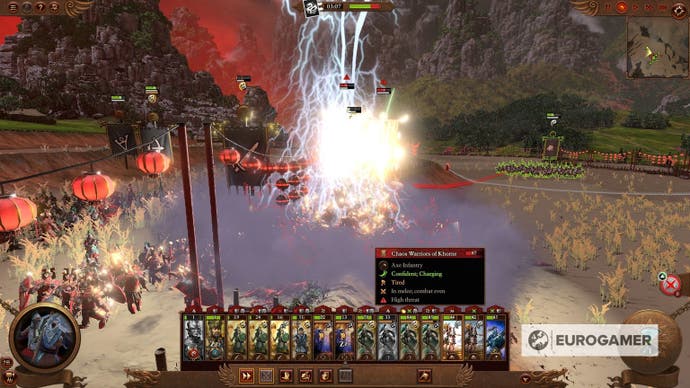


Fortunately it's a mix of the two, and I'm leaning towards the former. The same goes for those little romps in the Chaos Realms themselves. All four are different - in Khorne's realm you need to build up a kind of rage meter before taking him on for instance, while in Tzeentch you need to navigate a kind of unlabelled teleporter maze, which reminded me, of all things, of being eight years old and lost in the bowls of Pokémon Red's Silph Co. Tzeentch's was fun. There are some nice trade-offs, where you're rewarded for getting somewhere or defeating someone in that realm with a choice between things like fully healing your armies and pulling in from global recruitment pools, or having one of the several teleporter destinations revealed to you. But again, there's the odd drawback. The randomised nature of Tzeentchville meant that another enemy army, from Slaanesh, which entered it at the same time as my own, happened to take the right teleporter which took is straight to the final boss, while I was off making complex deductions about which-leads-where like some kind of chump. Slaanesh beats the Tzeentch boss and that's it, Tzeentchville's closed and I'm booted out, time wasted.
It's a tumultuous, dramatic, thrash-metal feast of stuff-on-screen. A strategy game of everything at once, instead of one deliberate step at a time.
This also touches on one of the other, minor annoyances that come up with Warhammer 3. There are an awful lot of new things added and almost none of it is fully explained. That first time I entered the Tzeentch Realm and bumped into Slaanesh, who was maybe battling some local Teenzth army, I assumed they were just one of the many armies in the area, when I probably could've engaged with them and booted them out myself. I even got automatically dragged into a battle as reinforcements on their side. Admitting that might be an act of self-sabotage - I am a unique idiot in Total War - but it's the kind of thing you don't fully learn until you've experienced it, as is so often the case in this game. Next time, great, I'll know to punt them out of that realm as soon as I can, but in this case I'm now a soul behind everyone else and, in my experience so far, it's proven extremely difficult to make up for the lost time. It depends how it all ends - I haven't finished the campaign yet - but it's looking like a minor oversight of a new, underexplained system has cost me an entire campaign.
There are other examples of this. At one point I lined up two fully-stacked armies just outside of a Chaos-occupied settlement, with one Chaos army inside it and one tiny one just to the side. Somehow, one of my static armies was caught in an ambush by the tiny one of the static Chaos armies, and all three of theirs, including the settlement garrison, were able to attack my own - which was marching in the typical ambush scenario despite, again, not moving on the map. Maybe it was a bug, in which case these things happen and I'm sure it'll be fixed. Alternatively, maybe this type of Chaos Lord has a special ability that lets it perform this kind of special reverse ambush, in which case it would've been nice to know about that beforehand.

Similarly the real-time battles are more dramatic, anarchic and genuinely enthralling than ever, but that anarchy does bring an element of, well, disorder. When fighting against Chaos, the challenge - especially with Cathay, which has a system that buffs your units significantly when they're in a well-organised formation - is just to keep on top of everything going on. New, ultra-fast units place heavy emphasis on flanking, while Pink and Blue Horrors - those bastard multi-damage shield-regenerating enemies I mentioned earlier - will taunt you into breaking formation to close them down. It's a long way from the old sacred triangle of melee-cavalry-ranged, and again it will take intense concentration and knowledge to really master. Beyond unit types, armour types, damage types and size types are a dizzying suite of spells, items and augments. This will be exhilarating for veterans who want something new to master and exhausting, I suspect, for proper newcomers, despite the added tutorials. I think I'm puffing along somewhere in the middle of the pack.
And maybe that's on me! Maybe I should've paid more attention in the warmonger school of Warhammers 1 and 2. But this is the crux of it with Warhammer 3 anyway: it asks a lot of you. Demands it, even. It is a demanding game. It's a tumultuous, dramatic, thrash-metal feast of stuff-on-screen. A strategy game of everything at once, instead of one deliberate step at a time. You feel it in the menus and the battles and the mechanics but even the visual design too, the flooding, all-out assault of colour and vibrance, the environmental detail of Warhammer 3's gorgeous, ridiculous world map. The brilliant nonsense of its sounds, the wonderfully over-the-top voice acting that's just bursting with enthusiasm - with enjoyment! I bet this game's cast had a blast in that studio.
Recently I caught myself - forgive me - explaining thrash metal to a friend who never got it. It's about building tolerance as much as anything, learning to find the layers to the sound, to acquire a taste for different parts of the palate. I wish I could've explained it through Total War. The more you learn of this game's enemies, the unit types, the little, hard-to-explain intricacies of campaign movement and engagement rules and rule exceptions and the rest - the more you slog it out through the onslaught of early-game detail and action all at once, the battle's Total Spectacle, the game's imperious wall of sound - the more you'll enjoy it. Right now, after a little while, I'm smitten. And exhausted. And really in the mood for some Slayer.
